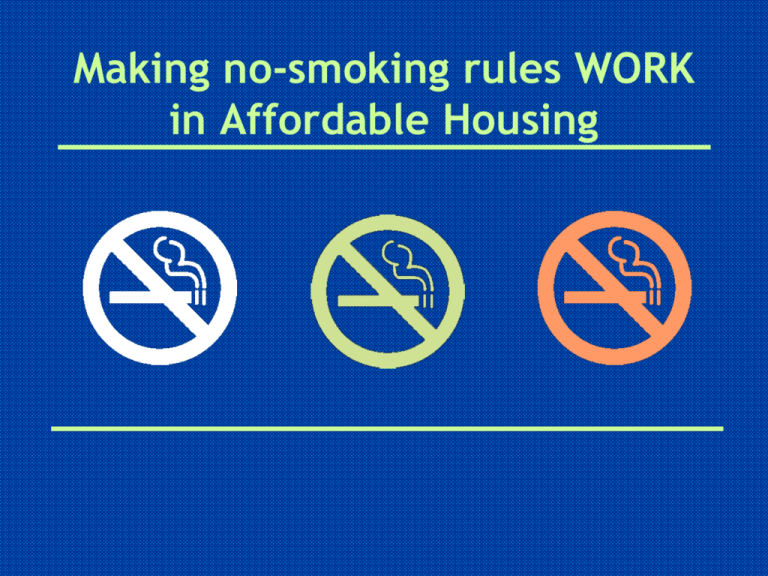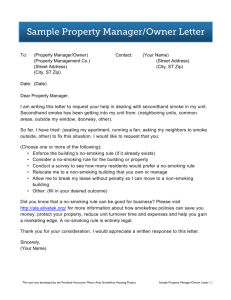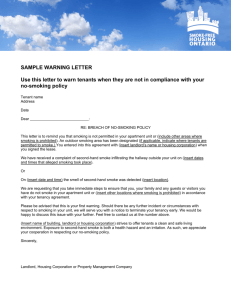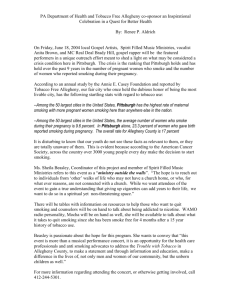Making No-Smoking Rules Work in Affordable Housing
advertisement

Making no-smoking rules WORK in Affordable Housing Today we’ll talk about • Trends • Why safe & healthy housing should not be a luxury • Steps and tools to implement a nosmoking policy • Understanding tobacco addiction Smoking: The world has changed In 1965, 1/2 of adult men and 1/3 of women in the US smoked and they did it: • • • • • • • At work On airplanes During college classes In hotels and theatres In restaurants, bars and taverns In their homes and In their beds Present Day • Most workplaces are smokefree • 85% of homes in Oregon and 87% in Washington have a no-smoking rule • People expect smoke-free air where they work and where they live What we know about SECONDHAND SMOKE There is no safe level of exposure to SHS: “The scientific evidence is now indisputable: secondhand smoke is not a mere annoyance. It is a serious health hazard that can lead to disease and premature death in children and nonsmoking adults.” U.S. Surgeon General, 2006 Children living in buildings where smoking is allowed… Have higher levels of nicotine markers in their blood. • SHS can seep into apartments where no one smokes through shared walls, ventilation systems and ductwork. • SHS is absorbed into furniture, carpets, curtains, clothing, toys, etc that children come into contact with and put in their mouths. Secondhand smoke cannot be controlled “At present the only means of effectively eliminating the health risks associated with indoor exposure is to ban smoking activity.” American Society of Heating, Refrigerating & Air-Conditioning Engineers “Treatments” can make it worse • Separating smokers from non-smokers, using air cleaning technologies, or ventilating buildings does not eliminate SHS exposure • Heating, ventilation and air conditioning systems can actually distribute SHS throughout a building What we know about RENTERS • 77% of Metro renters, regardless of smoking status, prefer to live in smokefree housing • 46% would feel uncomfortable living next door to a smoker • 74% say it’s OK for landlords to ban smoking Results were similar across all income groups Portland-Vancouver metro renter survey conducted 2009 by Campbell DeLong Resources, Inc What we know about RENTERS and SMOKING How many renters do you think smoke? • Survey of Metro renters said: 23% (16% daily, 7% some days) How many renter households allow smoking inside? • 82% do not allow smoking anywhere inside + 6% where smoking occurs rarely or never Most tenants don’t smoke, and over half of those who do already go outside. Oregon and Washington Smokefree Laws • Almost every workplace and public place is smokefree in Oregon and Washington – This includes public and common areas and anywhere an employee must pass through in the course of their duties – Also no-smoking within 10 feet (OR) and 25 feet (WA) of any entrance, window or intake unit Prohibiting smoking is legal… Smokers are not a protected class. Nonsmokers may be eligible for protection from SHS under Fair Housing laws. “Property owners and managers have every right to restrict smoking in and on their property.” Fair Housing Council of Oregon New Oregon law for landlords • As of 1/1/10 landlords must disclose, as part of their rental agreement, whether or not smoking is: – Prohibited on the premises – Allowed on the entire premises – Allowed in limited areas on the premises • If smoking is allowed, the disclosure must state where it is allowed. HUD Weighs In HUD strongly encourages public housing authorities and multifamily housing rental assistance programs to implement Non-Smoking policies for some or all of the units they own or manage. HUD Notice PIH-2009-21(HA) HUD Notice H-2010-21 National trends in public housing *This represents an increase of over 1,000% over the last 68 months. Safe and healthy housing should not be a luxury for those who can afford it Look familiar? Clean-up after a smoker; nicotine coats everything Portland Tribune photos Safe & Healthy Housing for ALL • Safe & healthy housing is key to a person’s physical safety and well-being. • Homes should not pose a serious health hazard to the people who live there. Safe & Healthy Housing for ALL • Residents in affordable housing have the least amount of choice and ability to move. • With long waits to get in, they are not likely to move out if they experience unwanted SHS at home. Safe & Healthy Housing for ALL • People with low-incomes already have higher rates of chronic disease and disability. • Exposure to SHS and tobacco use make this worse. How YOU can provide Safe & Healthy Housing A no-smoking policy is an easy and affordable way to: • Improve the indoor air quality of a building • Improve resident health No-Smoking policy might include: • All buildings • Inside the units • Porches,patios and balconies • Outside areas (such as playgrounds & pools) • Parking areas Communicating your policy • Make sure to use the words “non-smoking” or “smokefree” in your rental ads • Put the rule in writing - where smoking is and is not allowed - that it applies to guests too • Post adequate signage A no-smoking rule doesn’t mean “no smokers” It just means NO-SMOKING Enforcing your no-smoking rule Just like any other rule: • Residents can be your best allies – If a resident complains, document the facts and resolve the matter • Prompt consistent action will send a clear message – Lack of enforcement with one resident will make it difficult to enforce with others Understanding TOBACCO Addiction Who is Ready to Quit? 3 out of 4 Oregon smokers say they want to quit Why Don’t They Just Quit? Chain of Addiction: • Biologically Addictive • Psychologically Addictive • Culturally Addictive Adapted from materials produced by the Tobacco Cessation Resource Center, Washington State Department of Health Biological addiction to nicotine • Feeling of pleasure, decrease in anxiety • Lasting chemical changes in brain • Quitting produces withdrawal symptoms Adapted from materials produced by the Tobacco Cessation Resource Center, Washington State Department of Health Psychological addiction to smoking • Triggered by other behaviors – Having drinks or coffee, driving, etc • Self-medication Adapted from materials produced by the Tobacco Cessation Resource Center, Washington State Department of Health Cultural/Environmental link to nicotine addiction • Friends who smoke • Activities that involve smoking • Advertising • Movies • Places that still allow smoking Adapted from materials produced by the Tobacco Cessation Resource Center, Washington State Department of Health What’s in a Cigarette? 4000 chemicals, 50 carcinogens Benefits of Quitting 20 Minutes 2 Weeks-3 Months Blood Pressure Circulation improves Body temp in feet/hands Lung function increases 8 Hours C02 Level decreases to normal Oxygen level increases to normal 48 Hours Taste/Smell improves 1 year - Risk of coronary heart disease decreases by 50% 5 years - Stroke risk is reduced to that of never-smokers 10 Years Lung cancer death rate decreases by 50% Source: The American Lung RiskAssociation of Heart Disease almost Nerve endings begin regrowth The average person makes 2-3 serious quit attempts before finally quitting Adapted from materials produced by the Tobacco Cessation Resource Center, Washington State Department of Health No-smoking rule supports cessation Cessation supports no-smoking rule • Moves people along quitting continuum • Makes rule easier to enforce • Prevents relapse • Creates supportive environment for no-smoking policy • Creates supportive environment to stay quit One last thought A disgruntled resident from Housing Authority of Portland said (in a March 2009 Tribune article) “If you can’t afford to buy a condo or your own house, it’s going to be very difficult to smoke in your own home.” Think of it this way You shouldn’t have to buy your own home to be protected from secondhand smoke. For more information and tools, go to www.smokefreehousinginfo.com Oregon Smokefree Housing Project diane.laughter@ comcast.net Developed by Diane Laughter, MPH, of Health In Sight LLC This work is funded by the Tobacco Prevention & Education Program, Oregon Health Authority








